This essay was originally published in The Public Domain Review under a Creative Commons License. Please see their rules for reuse.
This year marks the 400th anniversary of the death of Miguel de Cervantes, author of one of the best-loved and most frequently illustrated books in the history of literature — Don Quixote. Rachel Schmidt explores how the varying approaches to illustrating the tale have reflected and impacted its reading through the centuries.

F
our hundred years ago, on April 23, 1616, Miguel de Cervantes died. In the prologue to his posthumously published The Trials of Persiles and Sigismunda, he poked fun at his upcoming death and the little literary fame he achieved in his lifetime. As the aging author rode a nag on the road to Toledo, a student catching up to him from behind hailed him with these words, “Yes, yes, this is the complete cripple, the completely famous and comic writer, and lastly, the delight of the muses!” Cervantes could not accept this faint praise, and replied, “That is an error into which many of my uninformed admirers have fallen. I, sir, am Cervantes, but not the delight of the muses or any of the other foolish things that you have mentioned.” Cervantes finished the prologue by taking leave of his readers: “for I am dying and hope to see you soon, happy in the life to come!”1
The literary fame Cervantes gained in his lifetime was for writing Don Quixote de la Mancha. The book tells the story of Alonso Quijano, a country gentleman whose limited estate has been eaten away by the costs to both his purse and mental stability caused by his non-stop consumption of chivalric romance. Proclaiming himself the knight errant Don Quixote de la Mancha in an age when knights no longer exist, he sets off, accompanied by the peasant Sancho Panza, to right imaginary wrongs, only to meet with beatings by those who consider him at best a madman, if not a fool. After being taken home in a cage by his neighbors at the end of Part One, Don Quixote hits the road again in Part Two, this time to encounter readers of his previous misadventures, including a duke and duchess who turn the would-be knight errant and squire into court entertainment.
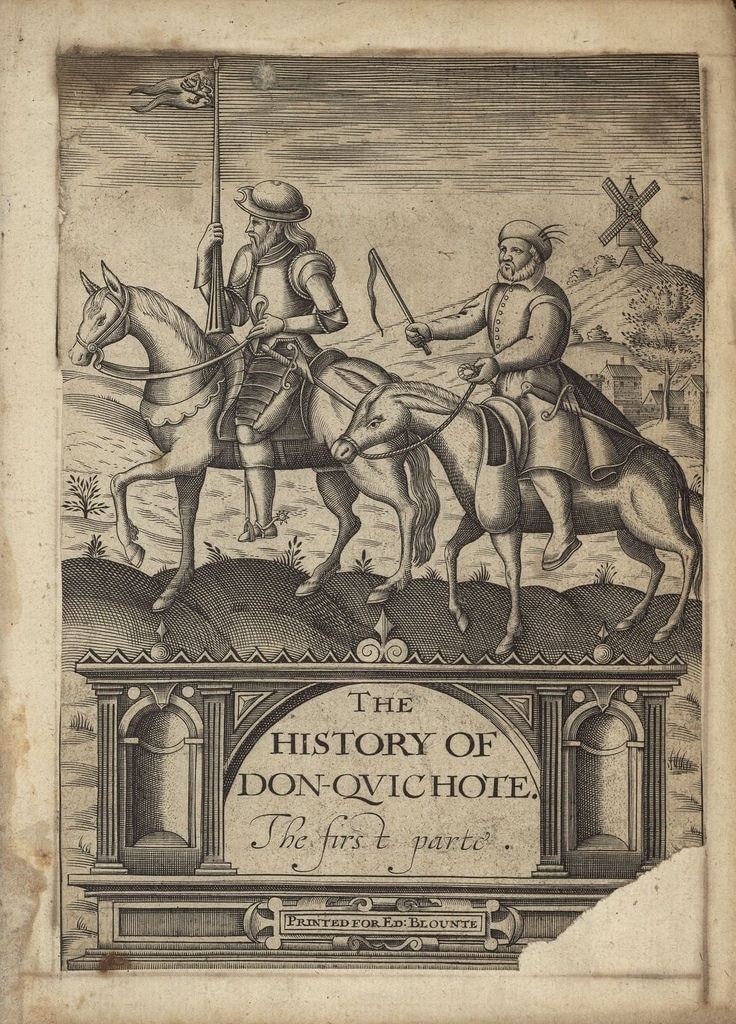
Published in 1605, Part One gained sufficient popularity to inspire translation into English by Thomas Shelton, probably by 1612, and into French by Cesar Oudin by 1614, as well as a spurious continuation from 1614 by the pseudonymous Alonso Fernández de Avellaneda. Already having begun Part Two (published in 1615), Cervantes reacted against Avellaneda’s sequel by changing his characters’ route and taking angry swipes at the impostor. Nonetheless, the generic identity and even the intent behind his beloved work had bothered the author from the beginning. In Part One’s prologue, an unnamed friend advises Cervantes, who struggles with writer’s block, that his goal be “demolishing the ill-founded apparatus of these chivalric books, despised by many and praised by so many more, and if you accomplish this, you will have accomplished much.” What is more, reading Don Quixote was to “move the melancholy to laughter, increase the joy of the cheerful, not irritate the simple, fill the clever with admiration for its invention, not give the serious reason to scorn it, and allow the prudent to praise it.”2
Whatever Cervantes’ initial idea, in the course of the last four hundred years, Don Quixote has embarked on a journey in the world imagination that has taken the literary character far beyond its original conception. The book illustrations of Cervantes’ Don Quixote would play a decisive role in this — not only transforming the image of Don Quixote and his loyal servant Sancho Panza but also giving life to the image of Cervantes himself.
Seventeenth-century images emphasized the title character’s pompous folly as well as the often rough-and-tumble action of many episodes. The windmill scene, in which Don Quixote mistakes for giants the technology that grinds the grain produced in the semi-arid Manchegan landscape, became immediately iconic. The first representation of the scene appears in a Frankfurt edition of 1648, in which the windmill sail stabs Don Quixote.
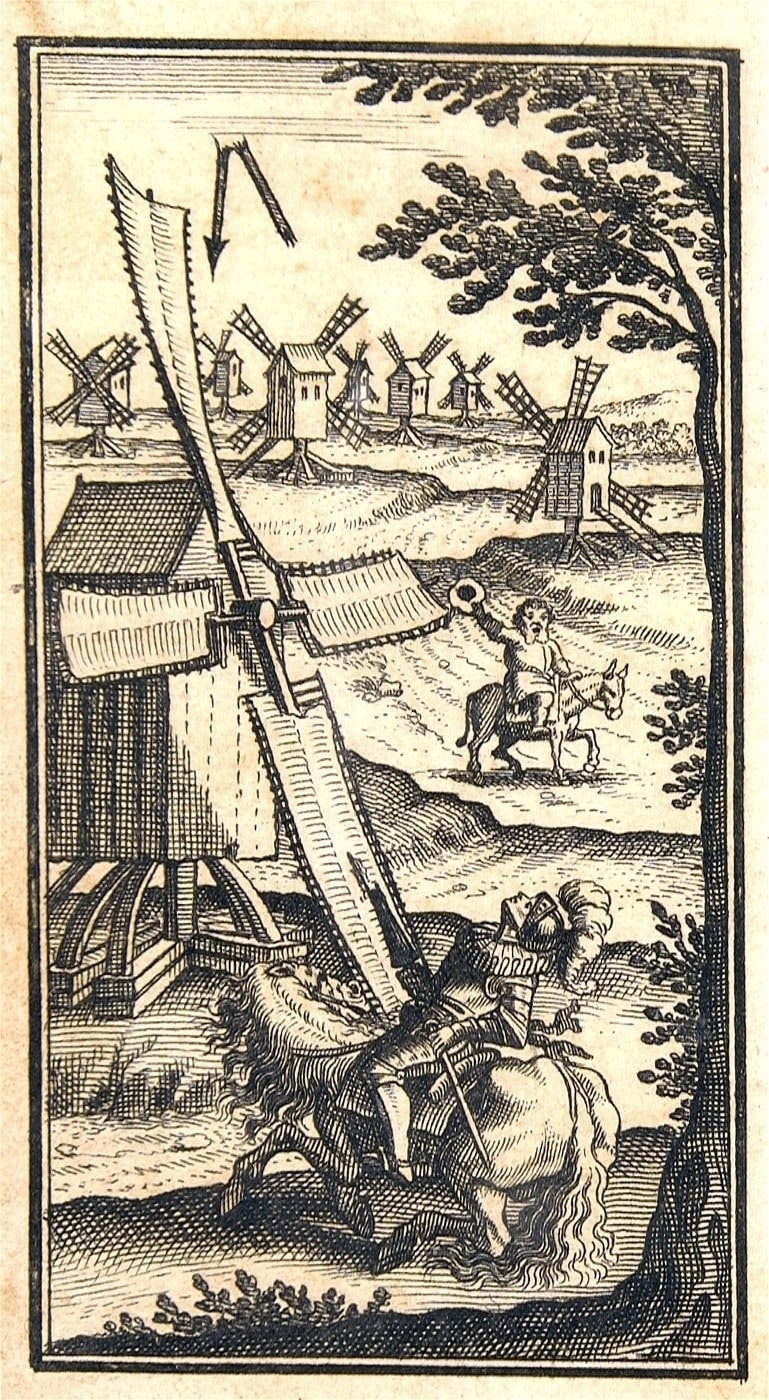
The frontispiece to the 1687 London Hodgkin edition also captures important motifs of early visual interpretation. The presence of the windmill identifies this otherwise English countryside as the setting for Don Quixote’s adventures, as it already did in the title page to the 1620 London Blount edition (see the second image featured above). In the foreground Don Quixote proudly wears the basin that he has claimed from a bewildered barber as Mambrino’s helmet, while Sancho, dominated by a beer belly, wears a dunce’s cap. Aldonza Lorenzo, the peasant Don Quixote names as his sweetheart when Sancho pushes for information about the imaginary Dulcinea, feeds pigs in the background.
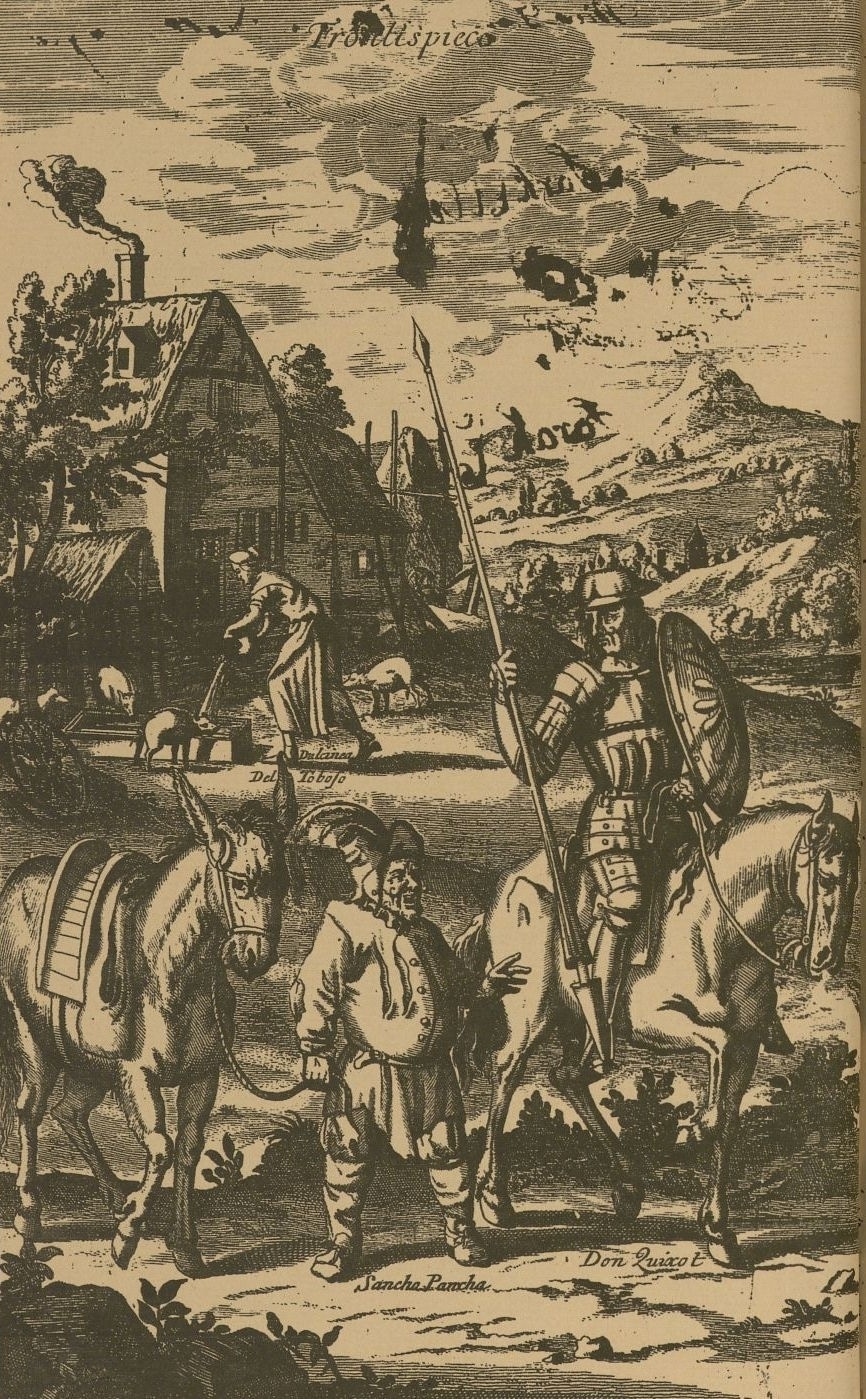
The iconographic tradition has already diverged from the novel in significant ways. In the text Sancho is described as having long shanks, but illustrators show him with the abundant belly that his name implies (Panza meaning “belly” in Spanish). The comic opposition of the short, fat peasant to the tall, lean would-be knight errant — a juxtaposition never developed by Cervantes — emerges early in book illustrations. Here the fictitious nature of the beautiful, virginal Dulcinea stressed by Cervantes remains unchanged, as the illustrator depicts Cervantes’ joke concerning a husky peasant woman who had the best hand for salting pork in all the neighboring countryside.
In the eighteenth century major changes came to the interpretation of Don Quixote, accompanied by a reappraisal of Cervantes. The advent of deluxe editions containing biographies of the author as well as abundant engravings, including illustrations of the episodes with allegorical frontispieces and maps, transformed the funny book into a monumental tome fit to take its place beside classics such as Homer, Dante and Horace on the learned reader’s bookshelf.
The 1738 London Tonson edition, published in Spanish and patronized by Lord Carteret, constitutes a monumental project. It boasts Gregorio Mayans y Siscar’s biography of Cervantes as well as two portraits of Cervantes, one presenting him as a sensitive man of letters and another as the allegorical hero Hercules Musagetes. The first, designed by William Kent and engraved by George Vertue, emphasizes the writer’s dignity, hiding the hand maimed at the Battle of Lepanto and framing him in drapery and books in a Gothic architectural setting. Cervantes clearly controls his characters, Don Quixote and Sancho, astride their mounts in a vaulted niche behind him.
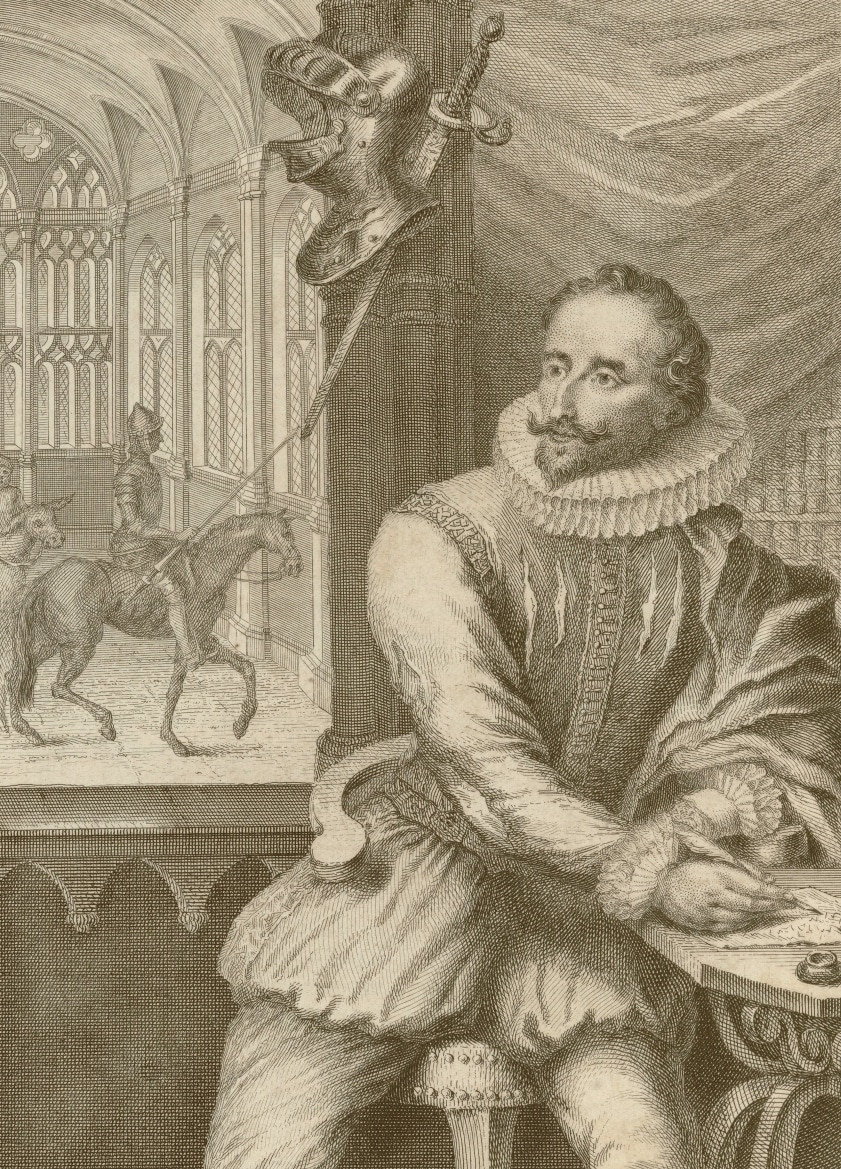
The allegorical portrait of Cervantes as a muscular Hercules, designed by John Vanderbank and engraved by Gerard van der Gucht, stands in sharp contrast. The author turns his back on the viewer and the pleading Muses, takes a club and a mask from a beckoning satyr, and strides toward Mount Parnassus to rid it of the monsters of knight errantry that occupy it.
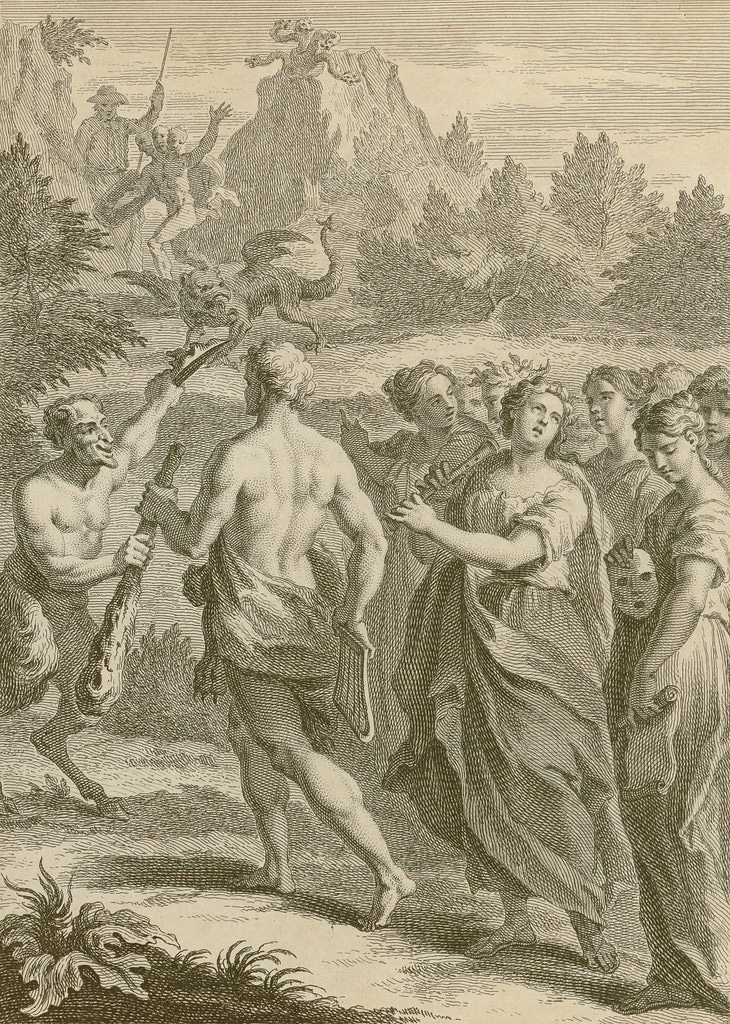
The meaning of the illustrations must have seemed somewhat slippery and unstable, for a certain Dr John Oldfield found it necessary to write accompanying explanations. The mask, which sports a heavy brow and craggy nose very similar to that of Don Quixote in the edition’s episodic illustrations, is “the proper implement for accomplishing [Cervantes’] end, viz. those of raillery and satire.”3 Whereas earlier commentators insisted on Cervantes’ parody of the popular literature of knight errantry, Oldfield and Mayans now attribute to the author satiric intent, clothing him in neoclassical attire. For Mayans, the literature of knight errantry is nothing less than barbaric, perpetuating the rule of brute power that followed the fall of Rome. Cervantes’ satirical attack on chivalric romance becomes, then, a defence of reason and, even, civilization.
In visual terms, elevating the novel to another genre translates to illustrating episodes that show Don Quixote not only as a fool, but also as a man of learning. In this sense, alternative narratives emerge in the illustrations. For example, Cervantes pokes fun at Don Quixote as his character discourses — before puzzled, illiterate goatherds — on the lost Golden Age when trees gave freely of their fruit and maidens rode untouched across the wilderness as virginal as the mothers who gave them birth. Not only does the would-be knight errant mangle the classical topic, but he does so for an audience who has no idea what he is talking about. When Vanderbank encapsulates this episode in its climactic moment according to the norms of history painting, a very different vision emerges.
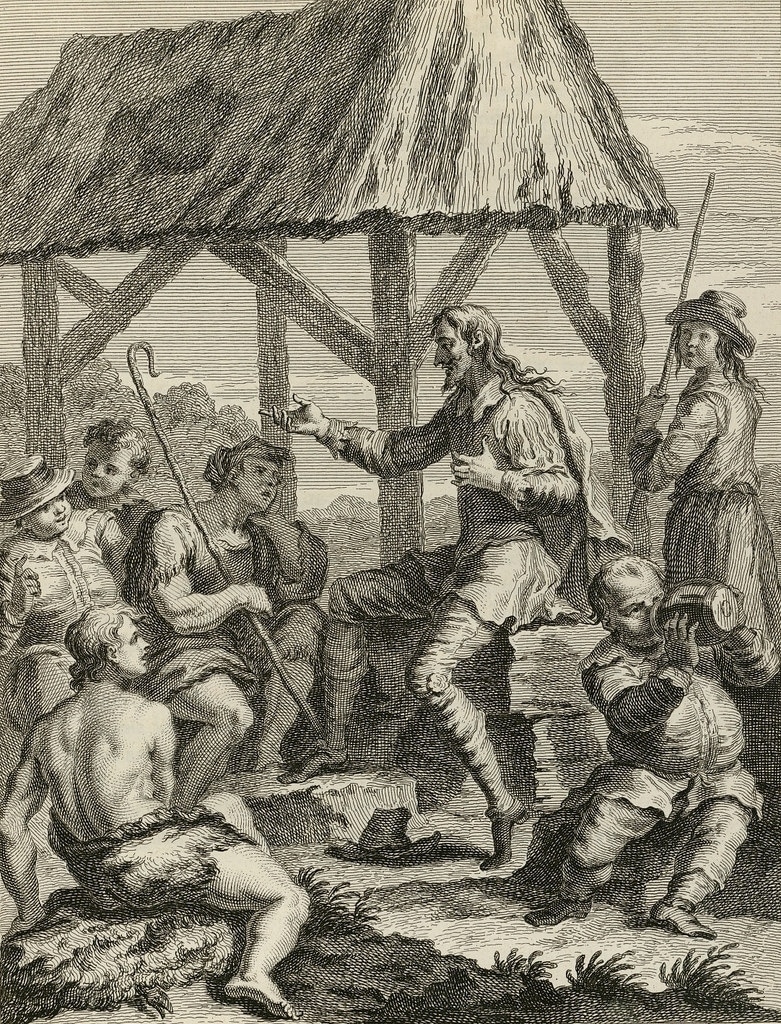
The goatherds listen raptly, as a youth presents his muscular back to the spectator but turns his head in respectful attention toward the distinguished Don Quixote. This setting of the central character, using the surrounding crowd to pull in the viewer’s eye, is seen in works such as Velázquez’s The Surrender of Breda. Indeed, the only person who ignores Cervantes’ madman is Sancho, who guzzles his wine bottom right. The visual neoclassical vocabulary fails to capture Cervantes’ irony, nor is it deemed fitting within the larger project of canonizing the novel Don Quixote to revert to depicting scenes of physical humor or of Don Quixote’s madness. In fact, this edition does not depict the infamous windmill scene at all.
Although the 1780 Madrid Ibarra edition, patronized by the Real Academia de la Lengua, complements the 1738 London Tonson edition in its canonizing impulse, certain components demonstrate how the language of neoclassicism, both visual and critical, can give way to a sentimental reading of the novel in which Don Quixote emerges as a hero. In his analysis of the novel, Vicente de los Ríos notes glimpses of wisdom within the character of Don Quixote, and observes that when not dealing with issues of knight errantry, the madman always behaves as an educated gentleman. Among the several illustrators whose drawings were engraved for this monumental edition, José del Castillo ventured into a heroic vocabulary. In an illustration of Don Quixote’s beating by mare herders engraved by Pedro Pascual Moles, Castillo grants the fallen character dignity and strength, as he offsets the brutish beating by the two peasants with his outstretched shield.
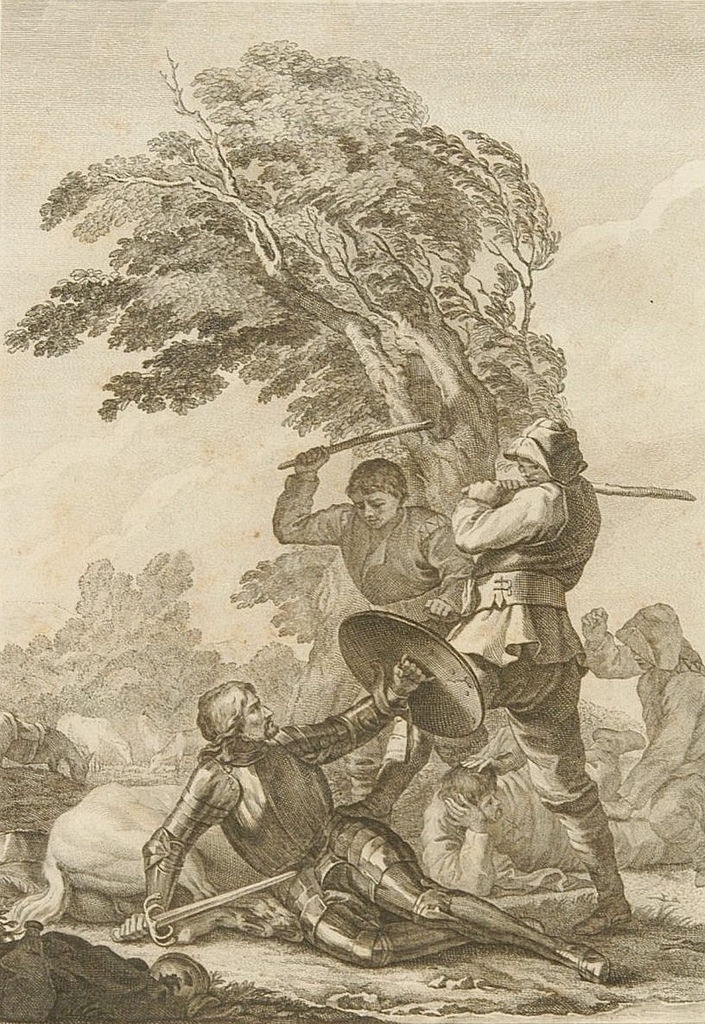
His profile is strong, middle-aged, and handsome; his gaze valiant. Even the compositional curve formed by his attackers and the tree behind them is anchored by the firm Don Quixote at their feet. All this, of course, illustrates a violent encounter occasioned by an event perhaps more comic than dignified: the randy nag Rocinante’s unwelcome sexual advances upon the mares.
With the advent of mass-produced editions containing vignettes and full-page illustrations in the nineteenth century, comic and sentimental images often coexisted in the same volume. In the 1818 London Cadell edition Robert Smirke designed two quite different illustrations, both referring to Don Quixote’s penance in the Sierra Morena, in which the would-be knight errant took off his pants and performed acrobatic feats as proof of his devotion to Dulcinea. One is a full-page illustration, engraved by Francis Engleheart, showing Don Quixote seated half-naked atop a mountain peak, which has been interpreted as evidence of a “Romantic” reading of the novel.
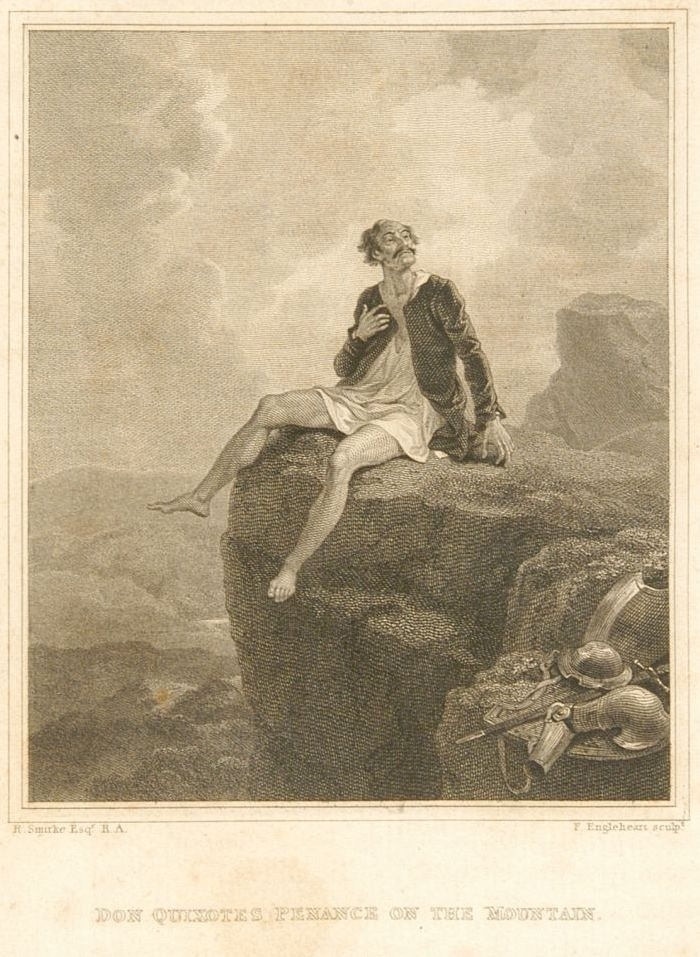
The other illustration, an accompanying vignette, clearly participates in the older, comic tradition as it shows Don Quixote upside-down with bare legs akimbo and Sancho Panza in the background, aghast at his master’s shamelessness.
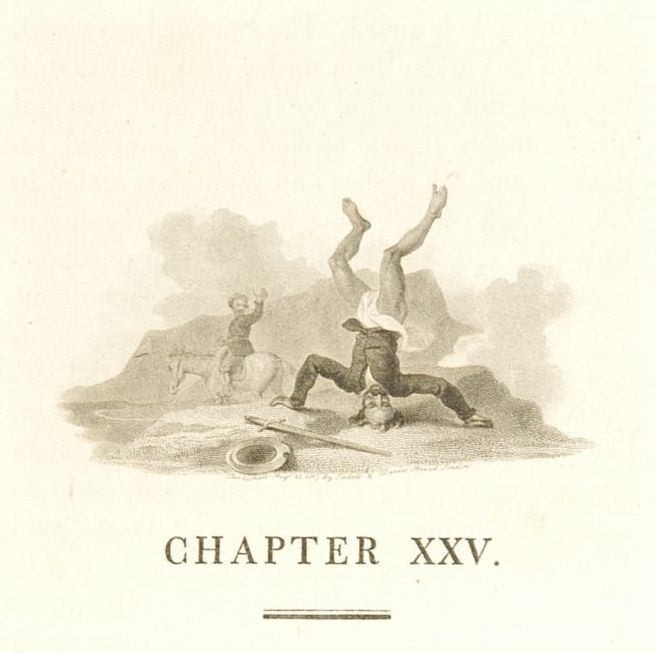
The production of vignettes along with full-page illustrations (already seen in deluxe editions) allows for a multiplicity of visual interpretations of Don Quixote side by side in the same edition.
In his illustrations for the 1863 Paris Hachette edition, Gustave Doré took advantage of the diversity of the iconographic traditions to create a visually exuberant and even contradictory vision of Cervantes’ novel. The French illustrator carried the sentimental tradition to its extreme, seeing not only Don Quixote as the hero he believed himself to be but also seeing the world from his perspective. Granted new technical capacity to explore dark tones through wood engraving, Doré reveled in depicting night scenes, wringing from them their lugubrious ambient qualities. In the illustration engraved by Longacre after Doré’s drawing of a fictitious procession of “Merlin”, rigged by a duke and duchess to manipulate Don Quixote and Sancho, the artist capitalizes on white on black delineation to highlight the spectral quality the midnight scene would have had for the two frightened protagonists.
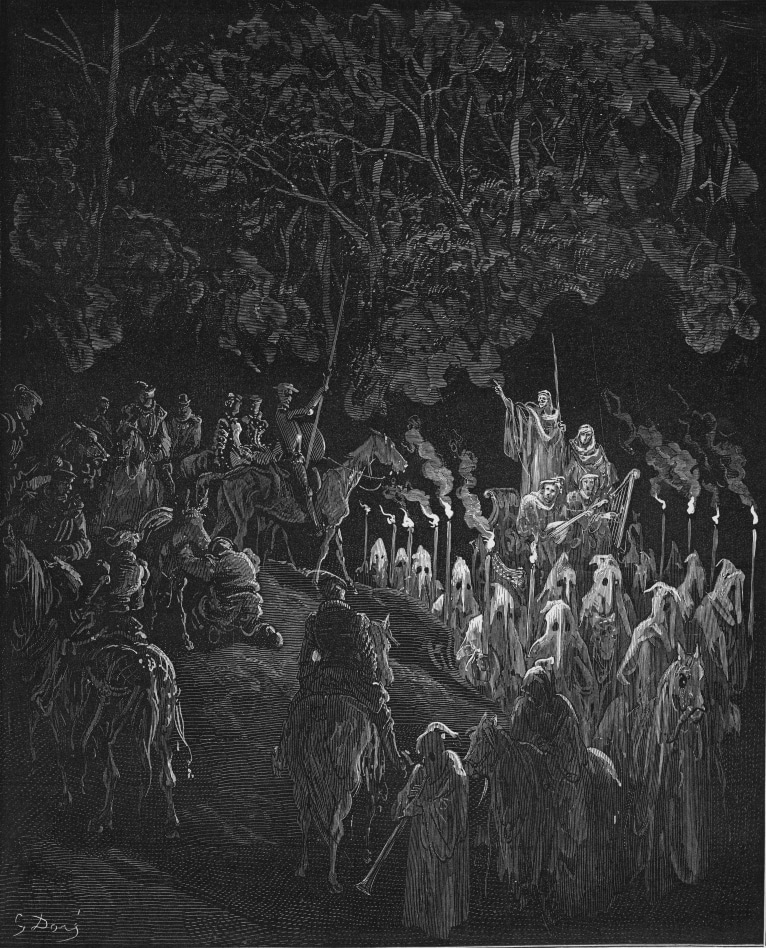
This vision of the episode allows readers to experience the knight errant and squire’s fear, and then to feel the disappointment and eventual loathing for the cynical aristocracy as the truth is revealed. This inversion of perspectives is another turn in the visual narrative. Nonetheless, Doré did not renounce the comic. Returning to the windmill scene, Doré foregrounds Don Quixote’s defeat as the tattered sail sweeps Rocinante into the air, exposing the horse’s underbelly and carrying the thwarted madman along a great arc that literally brings down to earth the vision of a battle between a hero and giants.
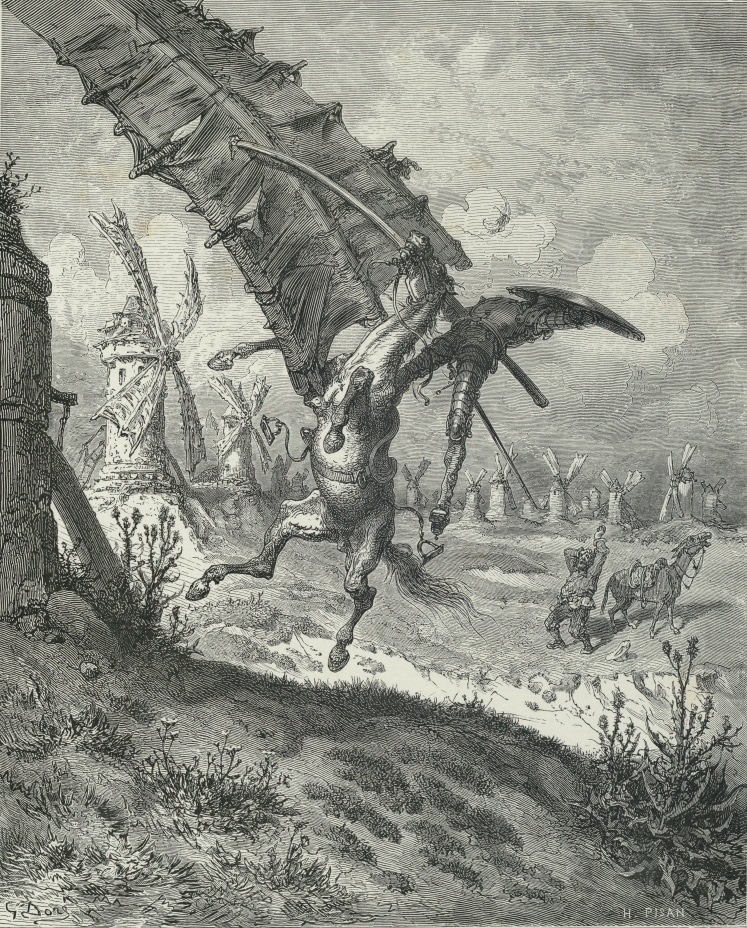
In the case of eighteenth-century deluxe editions, the move by publishers and literary biographers to canonize Cervantes and his novel was coupled with the illustrators’ neoclassical visual vocabulary that tended toward sentimentalizing Don Quixote. As editorial projects, these editions were monumental in scale and succeeded in envisioning Cervantes as a “classical” author, yet the illustrations depict an intentionally one-sided perspective on the novel’s complexity, sacrificing its humor and irony. Nineteenth-century editions, cheaply produced and including vignettes, reintroduced the comic episodes side by side with the sentimental. Even more influential was making visible the perspective of Don Quixote himself, in all its excessive attractiveness, as seen in Doré’s vision. So it is that the character Don Quixote slipped away from the straitjacket in which he had been held when considered a mere tool for attacking chivalric romances, and became a hero of the popular imagination. Cervantes had already glimpsed how slippery the claims to his wonderful nutcase would be, when in the prologue to Part One he quipped, “But though I seem to be the father, I am the stepfather of Don Quixote.”4
Rachel Schmidt is a professor at the University of Calgary. She is the author of Critical Images: The Canonization of Don Quixote through Illustrated Editions of the Eighteenth Century (McGill-Queen’s 1999) and Forms of Modernity: Don Quixote and Modern Theories of the Novel (Toronto 2011). She is currently working on a book about cosmology and politics in Cervantes’ last novel, The Trials of Persiles and Sigismunda.
Public Domain Works
Further Reading
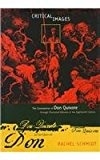
Critical Images: The Canonization of Don Quixote Through Illustrated Editions of the Eighteenth Century (McGill-Queen’s University Press, 1999) by Rachel Schmidt
An exploration into the impact of visual media on the literary reception of Don Quixote., one of the most illustrated books in the history of literature.
Doré’s Illustrations for Don Quixote (Dover Publications, 1982) by Gustave Doré
A collection of Gustave Doré’s wonderful images for Don Quixote — all 120 full-page plates, plus a selection of 70 vignettes.
Miguel de Cervantes, The Trials of Persiles and Sigismunda, A Northern Story, trans. Celia Richmond Weller and Clark A. Colahan (Berkeley: University of California Press, 1989), 15/16.↩
Miguel de Cervantes, Don Quixote, trans. Edith Grossman (New York: Harper Collins Publishers, 2003), 8.↩
John Oldfield, “Advertisement concerning the Prints,” in Miguel de Cervantes, The Life and Exploits of the Ingenious Gentleman Don Quixote de la Mancha (London: Tonson, 1742), I:XXXII. A Spanish transation is published in the 1738 London Tonson edition.↩
Cervantes, Don Quixote, 3.↩